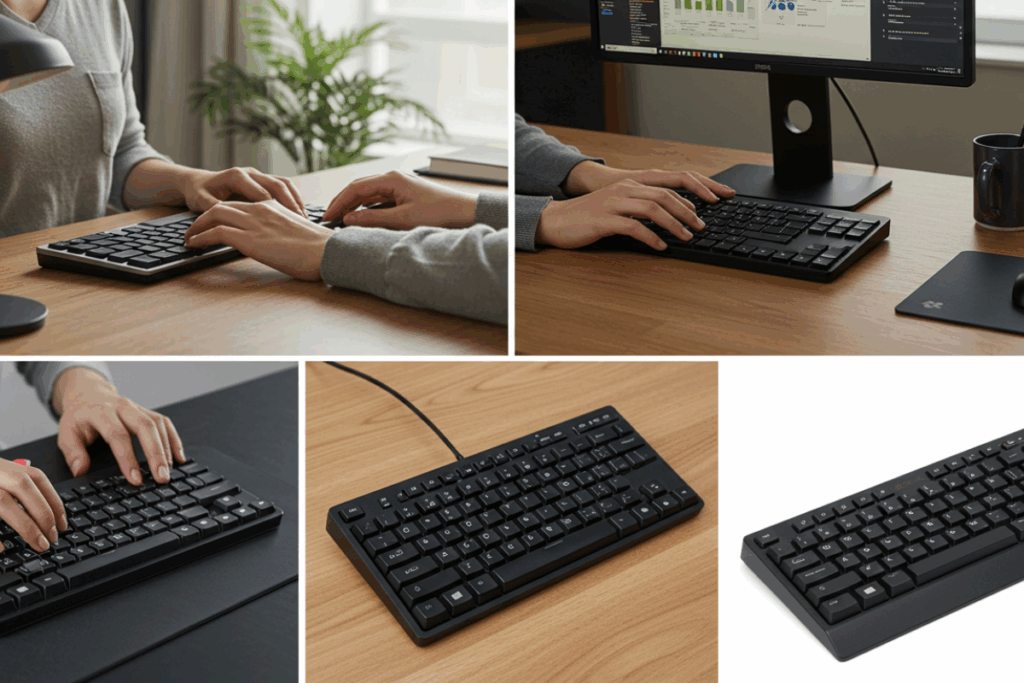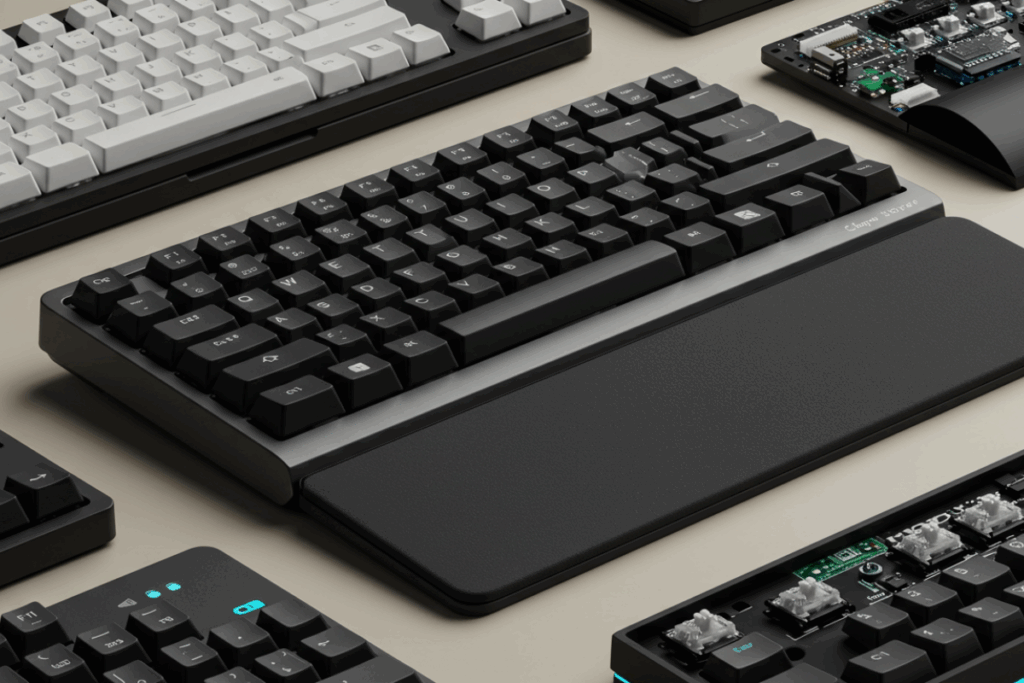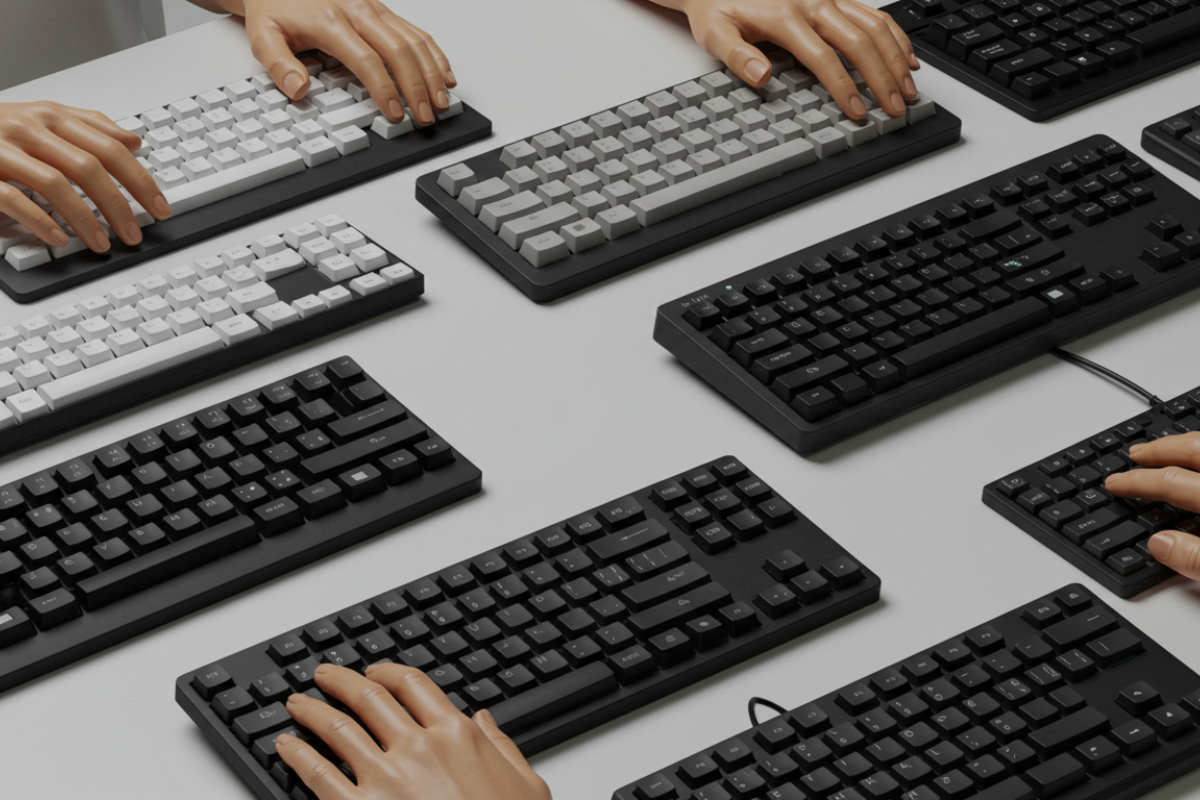best low profile keyboards are my go-to when I want faster typing and less wrist fatigue. At Keyboards Technology I put slim boards through real typing tests so you get honest results. I focus on reduced wrist strain, shorter key travel, quieter keys, and evaluate switch type, actuation, layout & connectivity, build quality, and customization. Writers, coders, gamers, and commuters all benefit from the right low-profile choice. Below are quick comfort facts, hands‑on notes, and a simple pre‑purchase checklist to help you pick the best low profile keyboards for your needs.
Key takeaway
- I choose Keyboards Technology for consistent low-profile comfort.
- Slim keys often deliver quieter keystrokes and a steadier feel.
- Shorter key travelfaster actuation = less fatigue and higher speed.
- A flat layout helps maintain a more neutral wrist position.
- My checklist helps find the best low profile keyboards that last.
How the best low profile keyboards reduce wrist strain and finger fatigue
best low profile keyboards change how hands feel after long typing sessions: they shorten finger travel and flatten wrist angle — less pain, more speed.
Reduced key travel and lower typing angle for better posture
I noticed the difference the first day. Keys move less. Fingers stop overreaching. That reduces forearm burn.
- Reduced key travel = shorter distance per press → lower repetition stress.
- Lower typing angle = wrists closer to neutral → less tendon pressure.
Comparison (approx.):
| Metric (approx.) | Traditional keyboard | Low-profile keyboard |
|---|---|---|
| Key travel | ~4.0 mm | ~2.5 mm |
| Actuation point | ~2.0 mm | ~1.2 mm |
| Typing angle | Raised | Flatter |
| Wrist strain | Higher | Lower |
Flatter keyboards keep elbows closer to the body, which fights fatigue fast.
Faster actuation and less finger fatigue with slim switches
Slim switches trigger sooner, so I press less hard and fatigue drops.
- Faster actuation = keys register earlier; fingers lift sooner.
- Less finger fatigue = less travel lighter presses.
Real note: after a week on a low-profile board, my WPM held and my hands felt fresher after four hours — critical for back-to-back meetings.
Quick comfort facts and measurements
| Fact | Value / Tip |
|---|---|
| Recommended wrist angle | Close to 0° or slightly negative |
| Typical low-profile travel | ~2–3 mm |
| Typical actuation | ~1–1.5 mm |
| Tip for relief | Use a low or no wrist rest. Keep the keyboard flat. |
| When to swap | If wrists hurt after 30–60 min, try low-profile boards |
I test comfort by typing the same paragraph for 30 minutes — if wrists feel looser, the keyboard wins.
What I check first when choosing the best low profile keyboards
Switch type: low-profile mechanical, scissor, or membrane
Switch type defines the keyboard’s personality.
- Low-profile mechanical: crisp, direct response; short travel and clear feedback — great for fast typists and gamers.
- Scissor: stable, quiet, laptop-like — ideal for office and travel.
- Membrane: soft and quiet; budget-friendly but less satisfying.
| Switch type | Feel | Noise | Best for |
|---|---|---|---|
| Low-profile mechanical | Crisp, tactile or linear | Moderate | Fast typists, gamers |
| Scissor | Stable, short travel | Quiet | Office, travel |
| Membrane | Soft, mushy | Very quiet | Budget, casual use |
I always type a few paragraphs on each switch; if it tires my fingers I move on.
Key travel, actuation force, and comfortable ranges
Two numbers matter most: key travel and actuation force. Short travel feels faster; low actuation force requires less push.
- Typical low-profile actuation: 1.0–2.0 mm
- Typical total travel: 2.0–3.0 mm
- Common actuation force: 30–45 g
| Feature | Range I prefer | Why it matters |
|---|---|---|
| Actuation travel | 1.0–2.0 mm | Faster input, less finger drop |
| Total travel | 2.0–3.0 mm | Cushion to avoid bottoming out |
| Actuation force | 30–45 g | Low fatigue, controlled typing |
A 1.2 mm actuation with ~35 g often feels fast and responsive; 1.8 mm with 40 g feels steadier. Pick based on how your hands feel after an hour.
My simple checklist for typing comfort
- Switch type: pick the feel you enjoy.
- Actuation travel & force: match your typing speed (~1.2–1.6 mm, 35–40 g).
- Keycap shape: low-profile, slightly scooped caps help placement.
- Stabilizers: smooth, quiet stabilizers reduce wobble.
- Wrist angle: flat or modest tilt lowers strain.
- Noise level: choose scissor or damped switches for quiet spaces.
- Build quality: solid frame and stable feet for precision.
- Connectivity: wired for zero lag, wireless for mobility.
If a keyboard ticks most boxes, it’s worth buying.
Types of low-profile keyboards: mechanical, scissor, and hybrid
I test boards for Keyboards Technology, so I know small differences matter. Here are the three main low-profile types and who they suit.
Low-profile mechanical: speed and variety
Low-profile mechanicals use shorter switches, so you press keys faster and tire less. Switch varieties include linear, tactile, and clicky.
| Switch type | Feel | Sound | Best for |
|---|---|---|---|
| Linear | Smooth | Quiet | Fast typists, gamers |
| Tactile | Small bump | Moderate | Writers who want feedback |
| Clicky | Bump click | Loud | People who like audible feedback |
I saw my WPM rise with a low-profile linear; tactile kept fingers comfortable during long drafts.
Scissor-switch: laptop-style stability
Scissor-switch boards use a cross clip under caps for a firm, flat feel: quiet, stable, shallow travel — common on laptops.
Pros: quiet, stable, low travel.
Cons: less feedback, fewer customization options.
I use scissor switches for notes and emails; they’re low-effort and wrist-friendly.
Which type suits different typing styles
| Typing style | Recommended type | Why |
|---|---|---|
| Fast, light fingers | Low-profile linear | Smooth action, quick return |
| Long-form writing | Low-profile tactile | Feedback reduces mistakes |
| Quiet office work | Scissor-switch | Low noise, steady keys |
| Mixed use | Hybrid | Combines feel and thin profile |
I prefer tactile for long writing; scissor is great for short messages and office work; gamers often lean linear.

How I test and compare the best low profile keyboards for typing comfort
Objective metrics: WPM, accuracy, fatigue
I track three numbers: WPM, accuracy, and fatigue over time — same method for all keyboards so comparisons are fair.
| Metric | What I measure | How I measure |
|---|---|---|
| WPM | Typing speed | Same 5-minute typing passage |
| Accuracy | Mistakes per 100 words | Count errors and percent correct |
| Fatigue | Change in speed/feel | Repeat test hourly over a 4-hour block |
A keyboard that starts fast but drops a lot isn’t great for long days.
Subjective checks: feel, noise, long-session comfort
Numbers tell one side. I pair them with hands and ears.
- Tactile feel: note travel, landing, and crispness.
- Noise: listen for thin, thocky, or clicky sounds; get a rough dB reading when useful.
- Long-session comfort: blocks of email, coding, and writing for 30–60 minutes; rate wrist/finger comfort 1–5.
Quick scoring grid:
| Check | Score 1–5 | What 1 vs 5 means |
|---|---|---|
| Feel | 1 = mushy, 5 = snappy | Crispness of action |
| Noise | 1 = loud, 5 = quiet | Desk friendliness |
| Comfort | 1 = painful, 5 = effortless | How hands feel after long use |
If my hands flag, the numbers usually agree.
Testing protocol I use for fair comparison
- Reset desk to same height and angle.
- Use the same machine and layout.
- 5-minute typing warm-up.
- 5-minute WPM & accuracy test.
- Three 1-hour real-work sessions (email, writing, code).
- Log scores and notes after each hour.
- 15-minute break before the next keyboard.
This keeps tests consistent and helps me pick the best low profile keyboards for real use.
Who benefits most from comfortable low profile keyboards
best low profile keyboards help people who type a lot — they cut wrist strain and speed up input. Key groups:
Writers, typists, and office workers
For long sessions, look for low key travel, gentle tactile feedback, low angle, and silent switches or dampening pads for quiet offices.
| Need | Feature to look for | Why it helps |
|---|---|---|
| Long typing sessions | Low key travel, gentle tactile feedback | Less finger fatigue |
| Wrist comfort | Low angle or adjustable feet | Keeps wrists flat |
| Quiet office use | Silent switches or dampening pads | Less noise for coworkers |
| Accuracy | Well-spaced layout | Fewer missed keys |
A compact layout with scissor or low-profile mechanicals often saves time and discomfort.
Gamers, travelers, and remote workers
Slim keyboards are easy to pack and often deliver faster actuation.
| User | Top feature | Benefit |
|---|---|---|
| Gamers | Fast actuation low-profile switches | Quicker response in games |
| Travelers | Lightweight, slim build | Easy to carry |
| Remote workers | Bluetooth long battery | Fewer cords, all-day use |
I’ve typed on trains with a slim keyboard — discreet and comfortable.
Match user needs to keyboard features quickly
| Problem | Quick fix |
|---|---|
| Wrist pain | Lower height, wrist rest |
| Slow typing | Stable key action, low travel |
| Too loud | Silent switches or dampening |
| On the go | Slim, light, wireless |
This grid is my starter map for recommendations.
Buying priorities and review criteria for the best low profile keyboards
Switch feel, layout, portability, and wireless comfort
I prioritize switch feel because it determines speed and accuracy. I test scissor, low-profile mechanical, and optical low-profile switches.
| Feature | Scissor | Low-profile mechanical | Optical low-profile |
|---|---|---|---|
| Travel (mm) | Short | Short–medium | Short |
| Tactile feel | Mild | Pronounced | Smooth |
| Noise | Quiet | Medium | Low |
| Best for | Laptops, office | Typists, gamers | Fast typists, mixed use |
Layout matters: full or TKL for comfort, 65% or compact for travel. Wireless testing includes Bluetooth and 2.4 GHz dongle — Bluetooth saves ports, dongles often offer lower latency for gaming. Count device pairing and battery life.
Customizability, noise, price
Customizability improves comfort: hot-swap sockets, adjustable feet, programmable layers are valuable. Noise control via foam or dampened switches matters. Keycap material affects sound; PBT caps are firmer and sound better than thin ABS.
Price tiers:
- Budget: basic wireless, fixed switches — good for students.
- Mid: hot-swap, better stabilizers, PBT caps — typists and hobbyists.
- Premium: aluminum case, low-latency wireless, full programmability — power users.
From my tests, Keyboards Technology performs well in mid and premium tiers.

Final pre-purchase checklist
- Switch feel — test tactile, linear, scissor if possible.
- Layout — full, TKL, or compact based on desk space.
- Portability — check weight and case thickness.
- Wireless modes — confirm Bluetooth and dongle options.
- Battery life — look for at least a week of regular use.
- Hot-swap — get it if you want to change switches.
- Keycaps — prefer PBT for a firmer feel.
- Noise control — dampening foam or quiet switches.
- Price match — align features with your budget.
- Brand support — prefer brands with good firmware updates and support.
Best low profile keyboards — quick picks
If you want fast suggestions, look for these categories when hunting the best low profile keyboards:
- Best for typing: low-profile tactile with ~1.2–1.6 mm actuation and 35–40 g force.
- Best for gaming: low-profile linear, fast actuation, reliable dongle mode.
- Best for travel: slim scissor or compact low-profile mechanical, lightweight case.
- Best budget pick: reliable membrane or scissor with good key stability.
- Best upgrade pick: mid-tier hot-swap low-profile mechanical with PBT keycaps.
Conclusion
The right low-profile keyboard is a small, smart upgrade: shorter key travel, faster actuation, and the right switch type cut finger fatigue and reduce wrist strain. Test for actuation, total travel, and a flat typing angle. Try before you buy when possible — my checklist saved me sore hands more than once.
Frequently asked questions
Q: What makes Keyboards Technology’s best low profile keyboards comfortable for typing?
A: Short key travel, low key height, stable build, and reliable switch feel reduce finger fatigue.
Q: Will a low-profile keyboard reduce my wrist strain?
A: A flatter hand angle generally helps; combined with proper posture and a wrist rest it often reduces strain, though it may not fix all pain.
Q: Which switch type should I pick for typing comfort?
A: Scissor or low-profile mechanical switches are my top picks: scissor for quiet and steady typing, low-profile mechanicals for snappy feedback.
Q: Are low-profile keyboards good for both typing and gaming?
A: Yes — faster actuation helps responsiveness. Look for models with n-key rollover and low-latency wireless or reliable dongle modes.
Q: How do I choose the best low profile keyboards from Keyboards Technology?
A: Test switch feel and layout, check wired vs wireless modes and wrist support, read reviews, and use return policies if necessary.

